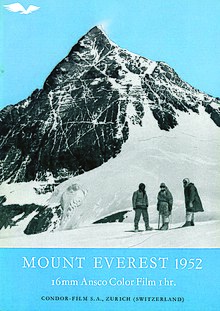1952 Swiss Mount Everest expedition
Led by Edouard Wyss-Dunant, the 1952 Swiss Mount Everest expedition saw Raymond Lambert and Sherpa Tenzing Norgay reach a height of about 8,595 metres (28,199 ft) on the southeast ridge, setting a new climbing altitude record, opening up a new route to Mount Everest and paving the way for further successes by other expeditions.
Origins[edit]
Tibet had closed to foreigners but Nepal had just opened up. In 1951 Eric Shipton's British-New Zealand reconnaissance had climbed the Khumbu Icefall and reached the elusive Western Cwm, proving that Everest could be climbed from Nepal. Unfortunately for the British, who had enjoyed exclusive access to the mountain for 31 years from Tibet to the north, the Nepalese government gave the 1952 permit to the Swiss.
Organization[edit]
Edouard Wyss-Dunant was appointed as the leader of this expedition. The other Swiss members were Rene Aubert, Leon Flory, André Roch and Raymond Lambert (despite Lambert's having suffered amputation of frostbitten toes).
All the Swiss were from Geneva. Most belonged to the exclusive «L'Androsace» climbing club and knew each other well. The city and canton of Geneva provided moral and financial support for the expedition, and the University of Geneva provided the scientific contingent.[1]
During this expedition Tenzing Norgay was considered, for the first time, a full expedition member ("the greatest honour that had ever been paid me"[2]) forging a lasting friendship with the Swiss, in particular Raymond Lambert.
Goals[edit]
The mountaineering task that this team had set itself was primarily exploring the access to the South Col, the conquest of the labyrinthine Khumbu Icefall, and possibly the advance to the South Col. The team never even considered an attempt at an ascent of Everest.[dubious ]
Ascent[edit]
Building on Shipton's experience, the Genevans reached the head of the Western Cwm and climbed the huge face above to the desolate, wind-swept plateau of the South Col. Three Swiss climbers and the Sherpa Tenzing Norgay continued towards the summit, pitching a tent at 8,400 meters. Two returned, leaving Tenzing and Lambert, who had become firm friends, to make a summit attempt. High altitude mountaineering in 1952 was still in its infancy. Even Swiss organisation and technology were not up to the job and, apart from Tenzing, the Sherpas had little experience. Despite the best plans, Tenzing and Lambert now had to spend a night at 8,400 m with no sleeping bags and no stove, producing a trickle of drinking water by melting snow over a candle. Edmund Hillary recalled in 1953 "an incredibly lonely sight, the battered framework of the tent that Tenzing and Raymond Lambert of the 1952 Swiss expedition pitched over a year before and where they had spent an extremely uncomfortable night without food, without drink, and without sleeping bags. What a tough couple they had been, but perhaps not very well organized." [3]
The oxygen sets were barely operable and when the two men continued in the morning, they were effectively climbing without oxygen. They struggled heroically, at times crawling on all fours, hindered by the dead weight of malfunctioning oxygen sets, finally grinding to a halt near 8595 m, about 250 m short of the summit.[4] Assuming that George Mallory and Andrew Irvine did not reach any higher during their expedition of 1924, this was the highest that anyone had ever been.
Results[edit]
Raymond Lambert and Tenzing Norgay were able to reach a height of about 8,595 metres (28,199 ft) on the southeastern ridge, setting a new climbing altitude record. Tenzing's experience was useful when he was hired to be part of the British expedition in 1953 during which he reached the summit with Sir Edmund Hillary.[5]
The results of this first Swiss expedition to Mt. Everest were remarkable, and exceeded even the most optimistic expectations. At the first attempt, it had opened up a new route to the peak of Everest, and it had reached an extraordinary height on the southwestern ridge in difficult conditions. In the opinion of the extremely critical (?) Marcel Kurz, this expedition could almost be compared to a victory. It paved the way for further successes by other expeditions.
The expedition named the Geneva Spur rock formation, between the Western Cwm and the South Col.[6] During the 1956 Swiss Everest–Lhotse expedition, Geneva Spur was the location of the last high camp before Fritz Luchsinger and Ernst Reiss achieved the first ascent of Lhotse summit, on May 18, 1956.[7]
Autumn expedition[edit]
There was a second Swiss expedition in the autumn of 1952, after the monsoon, the first serious attempt to climb Everest at that time of year. A party including Lambert, Tenzing and others made it to the South Col, but was forced back by extremely cold weather after reaching an altitude of 8,100 metres (26,575 ft).[2]
References[edit]
- ^ "Excerpt from: Swiss Foundation for Alpine Research, 1939 to 1970. Published in Zurich in 1972". Archived from the original on 2007-11-18. Retrieved 2011-01-09.
- ^ a b Tenzing Norgay and James Ramsey Ullman, Tiger of the Snows (1955, also published as Man of Everest)
- ^ Hillary, Edmund (1999). View from the Summit. Auckland: Doubleday/Random House. pp. 9, 10. ISBN 0-908821-09-3.
- ^ Cailliez, Jean-Claude (22 September 2007). "Raymond LAMBERT (1914-97) courageux & émérite alpiniste, moniteur de vol en montagne, co-patron de SATA". Le site des pionniers de l’aéronautique à Genève. Retrieved 2008-07-21.
- ^ "Tenzing Norgay GM". Imaging Everest. The Royal Geographical Society. Archived from the original on 2007-04-14. Retrieved 2007-06-21.
- ^ Bear Grylls - The Kid Who Climbed Everest (2004) - Page 226 (Google Books link)]
- ^ Aargauer Zeitung, 25 April 2006


